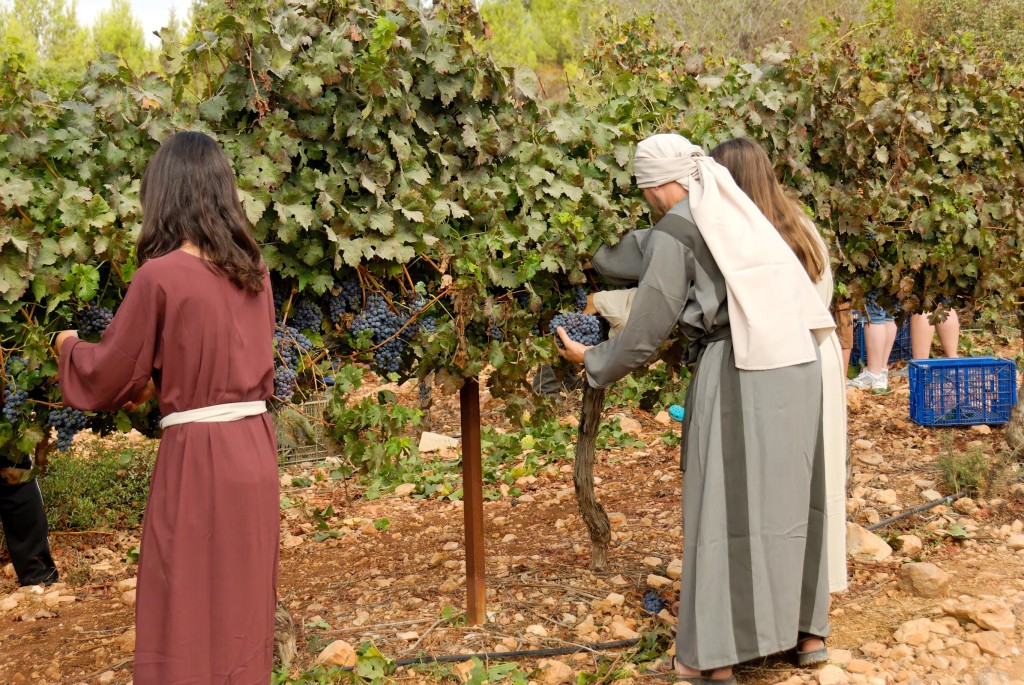In our day to day language we often use figures of speech to add colour and interest to our conversations. We might describe someone as being “as brave as a lion” or we might say someone is behaving “like a bull in a china shop.” A particularly uninteresting experience might be likened to “watching paint dry.” We understand that such language is not to be taken literally, but a comparison is being drawn between one thing and another in order to illustrate and emphasise the point that is being made. The Bible is full of this type of figurative language. Various figures of speech are used to help us understand what is being said, or to add interest, emphasis and expression to the text. One of the best known figures of speech we find in the Bible is the parable. Although we associate the parable with Jesus’ teaching, Jesus was not the first to use parables. Parables are found in the Old Testament as well as the New. The word “parable” is applied to a wide variety of pictorial statements from short proverbial sayings to the extended stories told by Jesus such as “the Good Samaritan.”
Definition
Our English word “parable” is a combination of two Greek words which literally mean, ‘to throw beside.’ W. E. Vine says a parable “signifies a placing of one thing beside another with a view to comparison” (1). Hence a parable may be defined as “a saying or story that seeks to drive home a point the speaker wishes to emphasise by illustrating it from a familiar situation of common life” (2). What distinguishes the parable from some other figures of speech is that the parable illustrates spiritual or moral truths by drawing a comparison with common objects and events from daily life.
Jesus and the parables
Although Jesus was not the first teacher to use parables it is with Jesus that we associate this method of teaching, and Jesus used the parable most effectively to convey his message in an interesting way. The frequency with which Jesus spoke in parables is indicated in Matthew 13:3, “And he told them many things in parables.” Mark 4:33-34 also notes,
“With many such parables he spoke the word to them, as they were able to hear it. He did not speak to them without a parable, but privately to his own disciples he explained everything.”
Any attempt to count the number of parables recorded in the Gospels depends on how broad a definition we take of the word “parable.” If we include the short proverbial sayings and similes uttered by Jesus then we may have sixty or more parables. If we limit our definition to the familiar story parables then there are perhaps thirty parables of Jesus. Most of the parables are recorded in the Gospels of Matthew and Luke, although Mark does record some not recorded by the others. Interestingly, there are no sayings or stories of Jesus recorded in the Gospel of John which are typically called parables.
Characteristics of Jesus’ parables
Jesus drew his parables from many sources. First, there were the parables from nature. These would include the parable of the sower (Matthew 13:3-9), the parable of the mustard seed (Matthew 13:31-32), the parable of the growing grain (Mark 4:26-29), and the parable of the barren fig tree (Luke 13:6-9). Jesus lived in an agricultural society and the people he was teaching were familiar with these processes. Second, Jesus drew his parables from the customs of the time. These would include the parables of the marriage feast and the great banquet (Luke 14:7-11,16-24) and the parable of the ten virgins (Matthew 25:1-13). Third, Jesus’ parables were drawn from the incidents of every day life (not necessarily actual events, but events which could happen). These would include the parable of the lost son (Luke 15:11-32), the parable of the labourers in the vineyard (Matthew 20:1-16) and the parable of the widow and the judge (Luke 18:1-8). So Jesus based his parables on the situations and incidents which were familiar to the people of his time. His parables referred to objects, customs, and practices which the people would have known about. Today, for us to understand the parables of Jesus we must consider them in their original context and familiarise ourselves with the customs of the day. This will aid our comprehension of these wonderful stories.
The parables that Jesus told were spontaneous. They had not been prepared beforehand to be delivered on a specific occasion. Rather, the circumstances Jesus found himself in gave rise to the parables. This is evident from Luke 14:7 where Jesus had been invited to a Sabbath day meal in the home of a Pharisee. Jesus observed how the guests were choosing the places of honour at the table. This led him to relate the parable of the wedding feast in which he teaches an important lesson on humility. From Luke 15:1-2 we see that the parables of the lost sheep, the lost coin and the lost son were told in response to the complaint from the Pharisees and scribes that Jesus was associating with “tax collectors and sinners.” Often the situation Jesus found himself in produced the opportunity to teach in parables.
The parables Jesus told were a very effective means to convey the truth he wanted people to grasp. The major impact of the parable often came at the end with an element of surprise. The parable of the merciful Samaritan (Luke 10:30-37) was told in response to a question posed by a lawyer, “Who is my neighbour?” The impact of the parable lies in the choice of a despised Samaritan as the hero of the story. We can only imagine what sort of impact this would have upon a Jewish audience.
The parables of Jesus were always told with a purpose. The parables were not just good stories to entertain or amuse the crowds. Every parable uttered by Jesus contained an important spiritual or moral truth. Those willing to listen would be able to understand and apply that lesson to their lives. This is what Jesus meant when he concluded his parables with the phrase, “He who has ears, let him hear” (Matthew 13:9,43).
Why did Jesus speak in parables?
After Jesus had told the parable of the sower (Matthew 13:3-9) his disciples came to him and asked, “Why do you speak to them in parables?” In his answer (13:11-17) Jesus gives two reasons why he uses parables. First, Jesus spoke in parables to reveal truth to those who were willing to hear and receive his word. The parables served to illustrate and clarify his teaching. With a few exceptions it was not necessary for Jesus to explain his parables. The truth was obvious to those who were willing to learn. The second reason Jesus spoke in parables was to conceal truth from those who were unwilling to receive it or obey it. Jesus answered the disciples’ question by saying “This is why I speak to them in parables, because seeing they do not see, and hearing they do not hear, nor do they understand” (Matthew 13:13). One of the effects of Jesus’ teaching in parables was that a distinction was drawn between those who were willing to hear and receive his word and those whose hearts were hardened to the truth and were unreceptive.
Some of the parables were spoken by Jesus to reveal to his enemies their real relationship to God. The parables of the two sons sent to work in their father’s vineyard, the wicked tenants, and the marriage feast (Matthew 21:28-32,33-46; 22:1-14) were all directed against the Pharisees and chief priests. The Pharisees and chief priests understood that Jesus had told these parables against them (Matthew 21:45). This group of parables revealed to the religious leaders their true attitude towards God.
The parables were also the means by which Jesus could cause people to acknowledge a truth before realising its personal application. This happened in the parable of the two sons sent to work in their father’s vineyard recorded in Matthew 21:28-32. The first son initially refused to work in the vineyard, but later repented and went to work. The second son said he would go and work, but failed to keep his word. Jesus asked the Pharisees the question, “Which of the two did the will of his father?” The question caused the Pharisees to acknowledge that the son who repented had done the will of his father. Jesus then drove home the truth of the parable by telling the Pharisees that “the tax collectors and prostitutes go into the kingdom of God before you.” The Pharisees had acknowledged the truth of the parable before realising its personal application to them.
Jesus also spoke in parables so that the truth taught in the parable might be persevered. The parable enables us to recall the story easily and then in recalling the story we remember the truth being taught.
Conclusion
Jesus’ use of parables proved to be a most effective method of teaching. In the parables Jesus taught many important and challenging truths in a way which is easy for us to remember and understand. Jesus’ words were not always popular, but they always demanded a response and a change of heart on the part of the hearers. Today as we read the parables of Jesus we too are challenged by the great lessons taught by Jesus through this method.
Notes
- Vine, W. E., Expository Dictionary of Bible Words, Volume 3, 158
- Bruce, F. F., “Parable” in The Zondervan Pictorial Encylopedia of the Bible, Volume 4, 590.
John Griffiths
 This article is from BiBloS, a teaching resource of the British Bible School. To read more articles or download the whole of Issue 2, click here.
This article is from BiBloS, a teaching resource of the British Bible School. To read more articles or download the whole of Issue 2, click here.


